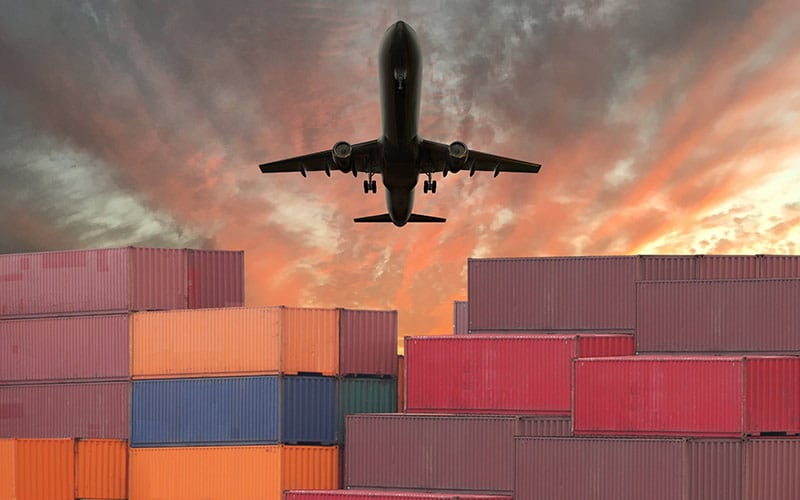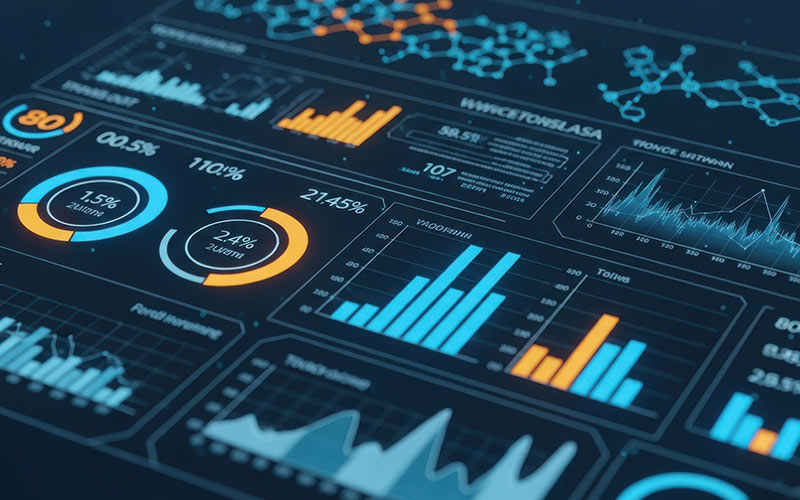
Insights
- Global CPG, retail, and logistics sectors are grappling with the impact of US tariffs.
- The sudden tariffs have caused supply chain volatility, price increases, and financial strain on companies.
- While AI can't eliminate tariff-related risks entirely, it plays a pivotal role in helping businesses build resilient, adaptive, and intelligent supply chain operations.
- AI-enabled supply chains leverage predictive simulations, real-time data, and scenario modeling to manage disruptions and forecast demand more accurately.
- But businesses will need to address organizational barriers such as organizational silos, short-termism, talent shortage, and change resistance to get the most out of AI.
Sudden and unexpected changes to tariffs unleashed by the US government in response to its own trade deficits have thrown CPG, retail, and logistics sectors worldwide into a state of flux. The US imposed a range of what it called “reciprocal tariffs” on a number of nations, including China, in early April. A deal was agreed in early May to ease the trade war, but uncertainty hangs over businesses around the world.
This uncertainty is hitting CPG, retail, and logistics businesses particularly hard. The Tax Foundation is estimating that customers will start seeing the reduction in availability of goods at US retailers due to an import reduction of $740 billion in 2025, or 22%. Meanwhile, Walmart, Best Buy, and Target have seen tariffs impact their share prices.
As for the CPG sector, commodities like coffee beans, cocoa, and spices are sourced from tariff-impacted countries, driving higher prices for these raw materials and forcing CPG brands to pass costs to consumers.
Commodities like coffee beans, cocoa, and spices are sourced from tariff-impacted countries, driving higher prices for these raw materials and forcing CPG brands to pass costs to consumers.
The logistics sector is also grappling with the impact of these trade conflicts and tariff uncertainties. From fluctuating demands to last-minute routing adjustments of international shipments, and unplanned tariff payments on en route goods, logistics providers are faced with volatile costs and unpredictable lead times.
As companies shift to alternative suppliers in lower-tariff regions, logistics providers will need to quickly adapt by rerouting shipments and reallocating resources. These companies are realizing that traditional models of supply chain management are not sufficiently resilient for times of flux and that they need to build intelligent supply chains bolstered by AI-driven insights to respond to challenges. AI tools for scenario planning and predictive simulations are increasingly vital for businesses to help them react to uncertainties.
A key underpinning of smarter, more resilient supply chains is the establishment of a unified data fabric: Clean, timely, and connected data flowing seamlessly across suppliers, logistics providers, warehouses, and retail points.

AI for smarter decisions
Businesses will need to address organizational barriers such as organizational silos, short-termism, talent shortage, and change resistance to get the most out of AI. They also need to solve technical barriers such as fragmented data sources and legacy systems, and the lack of data governance, to manage their response to tariff-related uncertainty.
Dynamic forecasting and scenario simulation: When the prices of agricultural raw materials used in CPG products increase, production costs inevitably rise. To navigate this, CPG companies can use what-if scenario modeling to forecast the financial impact and come up with potential responses.
These scenarios help decide how much of the cost increase can be passed on to consumers through price adjustments — while factoring in demand changes and customer willingness to pay based on past and recent purchase behavior. Insights from this analysis can also guide strategic decisions, such as deprioritizing low-margin products and shifting focus to higher-margin ones to maintain profitability.
Businesses can use AI and machine learning (ML) for simulation-based forecasting to consider the impact of a 20% tariff on aluminum or steel prices. For example, a cola company that relies on aluminum packaging can proactively gauge the cost implications and explore alternative materials to minimize the impact, while ensuring supply continuity and cost control. Infosys Topaz uses external variables and real-time data to simulate scenarios, helping companies quickly assess the impact of changes in tariffs and demand, and informing decisions about sourcing, routing, and inventory management. It can create a virtual replica of an entire supply chain to simulate tariff shocks and test different strategies before implementing them across a real supply chain.

Companies can use this tech to plan the network for movement of goods and services based on the customer’s location to mitigate the impact of shifting tariffs. For example, a global heating, ventilation and air conditioning (HVAC) and home appliances company needed to update its demand forecasting to cope better with rapidly changing conditions and supply chain volatility: It had been using manual demand forecasting methods and technology that lacked an AI element, which made it challenging for planners to forecast demand and respond to trend changes in real time. The company wanted to implement an AI-based forecasting solution to predict demand accurately, ensuring timely delivery of components for production — including replacement parts such as compressors, side panels, casing, and motors — that are part of the aftermarket service. Its intent was to align suppliers, logistics providers, and customers to meet supply chain volatility.
Companies can use this tech to plan the network for movement of goods and services based on the customer’s location to mitigate the impact of shifting tariffs.
Infosys helped the company create a demand forecasting workbench on Amazon Forecast. It used AI and ML to predict demand consistently and accurately over an 18-month period, assessing macroeconomic factors and external variables, enhancing forecast accuracy. It could essentially show the past actuals and the forecast for the next 18 months. It provided an aggregated view of forecasts based on the category or plant level, quarterly or annually. It helped reduce the demand forecasting timeline from days to seconds, allowing human resources to focus on extracting insights from forecasts. Infosys led the client to achieve an estimated annual savings of $2 million across supply chain and inventory costs.
To respond to demand effectively, H&M uses AI algorithms to pull out information from search engines and blogs, and predict what designs are popular with customers. Accordingly, it restocks those items based on the demand. This can be helpful for companies that are dealing with the unpredictability of demand owing to tariffs imposed to understand changing demand better and respond accordingly, while also avoiding wastage.
AI-driven automation of supply chain workflow: Businesses should introduce agentic architecture in the workflow in areas such as trade classification, cost structure, and compliance to help analysts make strategic decisions quickly. Unilever is using agentic AI for collaborative planning, forecasting, and replenishment. The system can run over 13 billion computations a day. The AI operates in real time, combining forecasted and actual sales data from both Unilever and its retail partners. It allows the company to track a product right from the source of its raw materials to when a consumer purchases it. This helps improve responsiveness and to reduce delays in replenishing stock. The system prevents disconnects between supply chains by sharing data openly and instantly. The enhanced forecasting accuracy is enabling greater resilience and agility — a requirement in the current tariff situation. It is also helping the company reduce human-related manual forecasting.
AI agents can help CPG and retail companies automatically analyze import and export goods, and classify them under correct tariff codes to reduce misclassification penalties and speed up cross-border processing. Agents can break down and analyze cost components such as duties, freight, and sourcing costs in real time to identify patterns or inefficiencies in supplier quotes. This information can help procurement teams negotiate better or shift to lower-cost sources faster. AI agents track evolving trade regulations, embargoes, or preferential trade agreements and flag when shipments or sourcing decisions may breach rules, minimizing regulatory risks and fines, and keeping operations agile.
When interacting with suppliers across multiple regions, businesses should use agentic systems to get optimal sourcing based on updated tariffs or disruptions, to auto-generate requests for quotes with built-in cost and compliance logic, and to simulate alternative supplier networks to fall back on.
Companies are using agentic AI to go through vast volumes of legal contracts and regulations quickly and streamline their research before making decisions. Agentic AI operates through defined workflows, autonomously retrieves pertinent legal information, applies regulatory frameworks, and generates compliant, legally accurate outputs with minimal human intervention. This can prove useful with the need to make well-informed decisions with agility in changing tariff situations. Coca-Cola is using agentic AI to study consumer trends and tailor its advertising to specific audiences, which can be used to influence customer behavior to fight competition in a tariffs scenario.
Companies are using agentic AI to go through vast volumes of legal contracts and regulations quickly and streamline their research before making decisions
Use real-time visibility tools: Businesses should use AI-powered visibility platforms to monitor their supply chains in real time — tracking shipments, supplier status, and market conditions across geographies. These tools integrate data from sensors, enterprise resource planning (ERP) systems, logistics partners, and third-party data sources such as weather, geopolitical alerts, or port congestion, offering a unified and dynamic view of the entire supply chain. Businesses can use this information to manage disruptions in sourcing, optimize warehouse locations for faster restocking, and for route optimization for speedier last-mile deliveries.
AI can’t be a standalone solution or fully shield businesses from the complex impact of tariff fluctuations, but it can play a crucial role in building resilience. By enabling faster scenario planning, smarter sourcing decisions, and improved supply chain visibility, AI helps organizations respond more swiftly and strategically to shifting trade dynamics. It doesn't eliminate risks, but it equips businesses to anticipate disruptions, minimize exposure, and adapt with greater agility.






